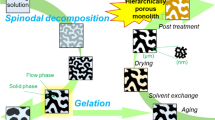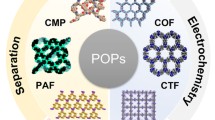Abstract
A novel method to prepare organic/inorganic composite particles, i.e. poly(methyl methacrylate)/CaCO3/SiO2 three-component composite particles, using emulsion polymerization of methyl methacrylate with sodium lauryl sulfate as a surfactant in an aqueous medium was reported. CaCO3/SiO2 two-component inorganic composite particles were obtained firstly by the reaction between Na2CO3 and CaCl2 in porous silica (submicrometer size) aqueous sol and the specific surface area of the particles was measured by the Brunauer–Emmett–Teller (BET) method. The results show that the BET specific surface area of the CaCO3/SiO2 composite particle is much smaller than that of the silica particle, indicating that CaCO3 particles were adsorbed by porous silica and that two-component inorganic composite particles were formed. Before copolymerization with methyl methacrylate, the inorganic composite particles were coated with a modifying agent through covalent attachment. The chemical structures of the poly(methyl methacrylate)/CaCO3/SiO2 composite particles obtained were characterized by Fourier transform IR spectroscopy and thermogravimetric analysis. The results show that the surface of the modified inorganic particles is grafted by the methyl methacrylate molecules and that the grafting percentage is about 15.2%.






Similar content being viewed by others
References
de LacyCostello BPJ, Evans P, Ewen RJ, Honeybourne CL, Ratckiffe NM (1996) J Mater Chem 6:289–294
Gvishi R, Narang U, Ruland G, Kumar DN, Prasad PN (1997) Appl Organomet Chem 11:107–127
Caris CCH, van Elven LPM, van Herk AM, German AL (1989) Br Polym J 2:133.
Jin LM, Chen YF, Zhang GC, Xie YS (1995) Funct Mater J 5:452–454
Hasegawa M, Arai K, Satio S (1982) J Polym Sci Part A Polym Chem 20:1021–1029
Hasegawa M, Arai K, Satio S (1987) J Polym Sci Part A Polym Chem 25:3231–3239
Bourgeat-Lami E, Lang J (1998) J Colloid Interface Sci 197:293–308
Bourgeat-Lami E, Lang J (1999) J Colloid Interface Sci 210:281–289
Wang Q, Xia HS, Zhang CH (2001) J Appl Polym Sci 80:478–1488
Yang Y, Dan Y (2002) IUPAC World Polymer Congress Preprints (II) 640
Yang Y, Dan Y (2002) Colloid Polym Sci
Tsubokawa N, Fujiki K, Sone Y (1988) Polym J 20:213–220
Silverstein RM, Bassler GC, Morrill TC (1982) Spectrometric identification of organic compounds. Science, Beijing, p 136
Liu YX (2001) Spectrometric identification. College of Chemical Engineering of Sichuan University, p 99
Silverstein RM, Bassler GC, Morrill TC (1982) Spectrometric identification of organic compounds. Science, Beijing, p 91
Nakatsuka T, Kawasaki H, Itadani K, Yamashita S (1981) J Colloid Interface Sci 82:298
Acknowledgements
The authors are grateful to the National Natural Science Foundation of China (29974021, 20034006) and the National Educational Ministry of China for support of this research.
Author information
Authors and Affiliations
Corresponding author
Rights and permissions
About this article
Cite this article
Jiang, L., Dan, Y. Preparation of poly(methyl methacrylate)/CaCO3/SiO2 composite particles via emulsion polymerization. Colloid Polym Sci 282, 1374–1380 (2004). https://doi.org/10.1007/s00396-004-1064-9
Received:
Accepted:
Published:
Issue Date:
DOI: https://doi.org/10.1007/s00396-004-1064-9




